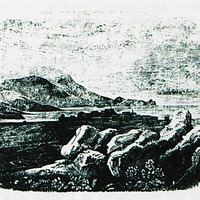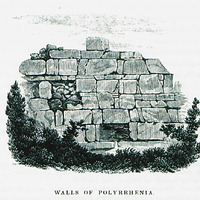Πολυρρήνια
Αντικείμενο
Τίτλος Σημείου Ενδιαφέροντος
el
Πολυρρήνια
en
Polyrrhenia
Περιγραφή / Απόσπασμα
81-84
en
I should think there can be no doubt that these are remains of the walls built by the Achaeans and Laconians, when they came and settled with the Polyrrhenians and fortified this strong place : and I have thought it worth while to give a sketch of them. Somewhat to the south of this wall, and about half way between the acropolis and its western extremity, are remains of what I suppose to have been a temple. The modern Greek chapel which has been erected on its site is now also in ruins.
Σύγχρονη περιγραφή
el
Η Πολυρρήνια ήταν αρχαία πόλη στη βορειοδυτική Κρήτη, περίπου 6 χιλιόμετρα νότια από το Καστέλλι Κισσάμου. Η πόλη άκμασε από τα αρχαία μέχρι τα ρωμαϊκά χρόνια και η επικράτειά της καταλάμβανε το δυτικό άκρο της Κρήτης. Το επίνειό της ήταν η Κίσσαμος. Η ακρόπολη της Πολυρρήνιας βρισκόταν στο ύψωμα πάνω από το χωριό Απάνω Παλαιόκαστρο, σε απότομο λόφο ύψους 418 μέτρων. Ο λόφος προσφέρει απρόσκοπτη θέα και φυσική οχύρωση, η οποία ενισχύθηκε με τείχος κατά τους ελληνιστικούς χρόνους.
en
Polyrrhenia or Polyrrenia (Ancient Greek: Πολυρρηνία; modern Greek: Πολυρρηνία, romanized: Polyrrinia), Polyrrhen or Polyrren (Πολύρρην) or Polyren (Πολύρην), or Pollyrrhenia or Pollyrrenia (Πολλύρρηνα), or Polyrrenion (Πολυρρήνιον) or Polyrrhenium, was a town and polis (city-state) in the northwest of ancient Crete, whose territory occupied the whole western extremity of the island, extending from north to south. It was an important Archaic Period settlement co-temporaneous with Lato and Prinias. Strabo describes it as lying west of Cydonia, at the distance of 30 stadia from the sea, and 60 from Phalasarna, and as containing a temple of Dictynna. He adds that the Polyrrhenians formerly dwelt in villages, and that they were collected into one place by the Achaeans and Lacedaemonians, who built a strong city looking towards the south. In the civil wars in Crete in the time of the Achaean League, 219 BCE, the Polyrrhenians, who had been subject allies of Cnossus, deserted the latter, and assisted the Lyctians against that city. They also sent auxiliary troops to the assistance of the Achaeans, because the Cnossians had supported the Aetolians. In a successful campaign they prevented their rival cities Cnossus and Gortys from dominating the entire island and brought a large part over to the Macedonian coalition. Polyrrhenia continued to flourish in the Roman period, when the center shifted to its erstwhile port, Cisamus, and in this urbanistic configuration lasted into Byzantine times. A small town now occupies the site, where rock-cut tombs, ruins and an acropolis remain. A Roman aqueduct built in the age of Hadrian improved water supplies.
The ruins of Polyrrhenia, have been discovered at a place called Epano Palaiokastro in the Chania regional unit.[9][10] It is some 7 km inland from modern Kissamos. A village of the same name has been established nearby, and the ruins are an archaeological site. The site exhibits the remains of the ancient walls, from 10 to 18 feet (3.0 to 5.5 m) high.[11] Systematic archaeological excavations have been conducted at the site since 1986.
The ruins of Polyrrhenia, have been discovered at a place called Epano Palaiokastro in the Chania regional unit.[9][10] It is some 7 km inland from modern Kissamos. A village of the same name has been established nearby, and the ruins are an archaeological site. The site exhibits the remains of the ancient walls, from 10 to 18 feet (3.0 to 5.5 m) high.[11] Systematic archaeological excavations have been conducted at the site since 1986.




